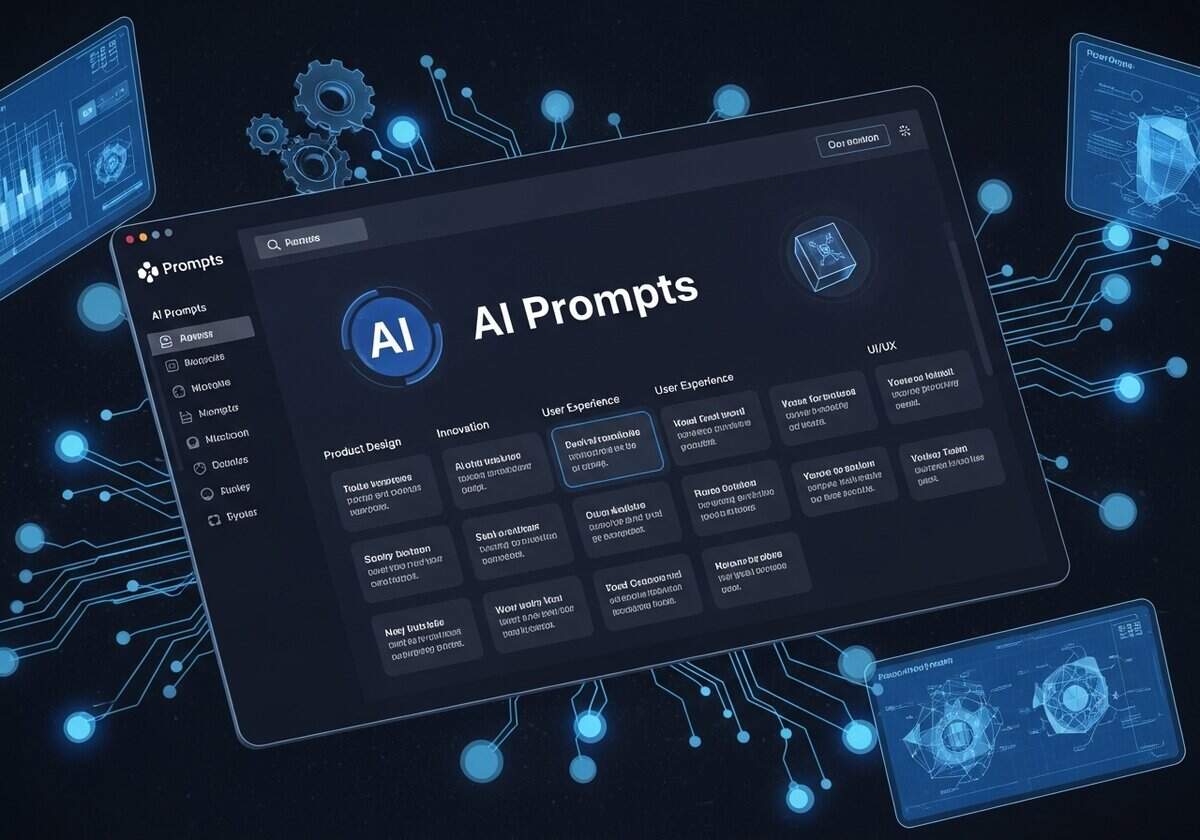Einfach das größte Verzeichnis für KI-Eingabeaufforderungen, spezialisiert auf Produktdesign und Innovation

Willkommen beim weltweit größten Verzeichnis für KI-Anweisungen, das sich mit fortschrittlichem Produktdesign, Technik, Wissenschaft, Innovation, Qualität und Fertigung befasst. Während Online-KI-Tools die technische Landschaft durch die Erweiterung menschlicher Fähigkeiten rapide verändern, entfalten sie ihre wahre Stärke erst durch präzise und fachmännisch ausgearbeitete Anweisungen. In diesem umfassenden Verzeichnis finden Sie eine Sammlung solcher Anweisungen, die es Ihnen ermöglichen, KI-Systeme zu steuern, die große Datenmengen verarbeiten, komplexe Muster erkennen und neue Lösungen weitaus effizienter als herkömmliche Methoden entwickeln können.
Entdecken Sie die exakten Eingabeaufforderungen, die Sie benötigen, um KI-Agenten für die Optimierung Ihrer Entwürfe im Hinblick auf Spitzenleistung und Herstellbarkeit, die Beschleunigung komplexer Simulationen, die genaue Vorhersage von Materialeigenschaften und die Automatisierung einer Vielzahl wichtiger Analyseaufgaben zu nutzen, und stimmen Sie diese ab.
Die erweiterten Suchfilter ermöglichen einen schnellen Zugriff auf dieses umfangreiche Verzeichnis und decken das gesamte Spektrum der modernen Technik ab.
Angesichts der Server-Ressourcen und des Zeitaufwands sind die Eingabeaufforderungen selbst nur registrierten Mitgliedern vorbehalten und unten nicht sichtbar, wenn Sie nicht angemeldet sind. Sie können sich registrieren, 100% kostenlos:
Mitgliedschaft erforderlich
Sie müssen Mitglied sein, um auf diesen Inhalt zugreifen zu können.
- Codegenerierung und Fehlersuche
AI Aufforderung an MATLAB Script for 2D Truss FEA
- Analyse der Varianz (ANOVA), Design für die Fertigung (DfM), Optimierung des Designs, Maschinenbau, Finite-Elemente-Methode (FEM), Werkstoffkunde, Maschinenbau, Simulation, Tragwerksplanung
Generates a basic MATLAB script to perform a Finite Element Analysis (FEA) on a 2D truss structure. The script will take nodal coordinates, element connectivity, material properties, loads, and boundary conditions as input.
Ausgabe:
- MATLAB
- erfordert kein Live-Internet
- Fields: {truss_geometry_and_properties_json} {load_and_boundary_conditions_json}
- Best for: Generating a foundational MATLAB script for 2D truss analysis, useful for educational purposes or as a starting point for custom FEA tools.
- Datengenerierung oder -erweiterung
AI Aufforderung an Create Construction Schedule Variations
- Agile Methodik, Gebäudedatenmodellierung (BIM), Bauingenieurwesen, Schlanke Fertigung, Projektmanagement, Risikoanalyse, Risikomanagement
Generates multiple plausible variations of a construction schedule by introducing delays or accelerations to activities based on specified risk factors and their potential impacts. Helps in Monte Carlo simulations or risk analysis.
Ausgabe:
- CSV
- erfordert kein Live-Internet
- Fields: {baseline_schedule_csv_activities_durations_dependencies} {risk_event_descriptions_and_potential_impacts_on_duration} {number_of_scenario_variations}
- Best for: Generating data for schedule risk analysis, Monte Carlo simulations, and contingency planning.
- Extraktion von Informationen
AI Aufforderung an Extract Material Properties from Text
- Additive Fertigung, Verbundwerkstoffe, Verbundwerkstoffe, Design für additive Fertigung (DfAM), Materialien, Mechanische Eigenschaften, Produktdesign, Produktentwicklung, Nachhaltigkeitspraktiken
Extracts specified material properties for given materials from a block of unstructured text like a report or specification. This helps in quickly populating material databases or creating comparison sheets without manual searching.
Ausgabe:
- JSON
- erfordert kein Live-Internet
- Fields: {document_text} {list_of_materials_and_their_properties_to_find}
- Best for: Populating material databases or comparison sheets from unstructured text, saving manual effort.
- Datengenerierung oder -erweiterung
AI Aufforderung an Create Synthetic Soil Bearing Capacity Data
- Bauingenieurwesen, Bauingenieurwesen, Design für Nachhaltigkeit, Optimierung des Designs, Umweltverträglichkeitsprüfung, Geotechnik, Werkstoffkunde, Qualitätskontrolle, Tragwerksplanung
This prompt generates synthetic soil bearing capacity data based on input soil parameters {soil_properties_json}. The AI should produce a JSON array with multiple data points showing allowable bearing capacity values under varied depths and footing sizes for civil engineering foundation design.
Ausgabe:
- JSON
- erfordert kein Live-Internet
- Fields: {soil_properties_json}
- Best for: Best for creating varied soil bearing capacity datasets for foundation design.
- Extraktion von Informationen
AI Aufforderung an Identify Key Structural Design Codes Cited
- Bauingenieurwesen, Bauingenieurwesen, Entwurfsanalyse, Konstruktionsdokumentation, Design für die Fertigung (DfM), Design für Nachhaltigkeit, Qualitätssicherung, Qualitätsmanagement, Tragwerksplanung
This prompt scans through the provided civil engineering document text {document_text} to identify and list all references to structural design codes (e.g., ACI, Eurocode, IS codes), including version/year if available. The AI must list codes uniquely and give a brief description of their scope if known.
Ausgabe:
- Markdown
- erfordert kein Live-Internet
- Fields: {document_text}
- Best for: Best for extracting references to design standards from technical documents.
- Fehlersuche und Diagnostik
AI Aufforderung an Troubleshoot Heat Exchanger Efficiency Loss
- Korrosion, Wirkungsgrad, Wärmebehandlung, Lecksuche, Wartung, Prozessverbesserung, Prozess-Optimierung, Qualitätskontrolle, Qualitätsmanagement
This prompt evaluates heat exchanger operational data and symptoms to diagnose causes of efficiency loss. The AI provides a markdown report outlining potential issues like fouling, leaks, or flow maldistribution with corrective recommendations.
Ausgabe:
- Markdown
- erfordert kein Live-Internet
- Fields: {heat_exchanger_data} {symptoms_description}
- Best for: Diagnose and address heat exchanger performance problems
- Fehlersuche und Diagnostik
AI Aufforderung an Troubleshoot Distillation Column Anomalies
- Chemisches Recycling, Kontinuierliche Verbesserung, Fehlermöglichkeits- und Einflussanalyse (FMEA), Prozessverbesserung, Prozess-Optimierung, Qualitätsmanagement, Ursachenanalyse, Statistische Prozesskontrolle (SPC)
This prompt takes detailed operational parameters and symptoms related to a distillation column and generates a structured diagnostic report identifying likely malfunctions, their causes, and recommended fixes.
Ausgabe:
- Markdown
- erfordert Live-Internet
- Fields: {operational_parameters} {symptoms}
- Best for: Identify and fix distillation column issues efficiently
- Fehlersuche und Diagnostik
AI Aufforderung an Diagnose Reactor Performance Issues
- Kontinuierliche Verbesserung, Korrekturmaßnahme, Fehlermöglichkeits- und Einflussanalyse (FMEA), Prozessverbesserung, Prozess-Optimierung, Qualitätskontrolle, Qualitätsmanagement, Ursachenanalyse, Statistische Prozesskontrolle (SPC)
This prompt helps diagnose common reactor performance problems by analyzing user-provided operational data and observed symptoms. The AI outputs a prioritized list of probable root causes along with suggested diagnostic tests or corrective actions.
Ausgabe:
- Markdown
- erfordert Live-Internet
- Fields: {operational_data} {symptoms_list}
- Best for: Systematic diagnosis of reactor malfunctions
- Hypothesenbildung
AI Aufforderung an Generate Hypotheses from Literature Summary
- Additive Fertigung, Chemisches Recycling, Kontinuierliche Verbesserung, Umweltverträglichkeitsprüfung, Innovation, Prozess-Optimierung, Forschung und Entwicklung, Nachhaltigkeitspraktiken, Nachhaltige Entwicklung
This prompt ingests a user-provided summary of recent literature on a chemical engineering topic and generates a list of potential hypotheses for further research, highlighting gaps or inconsistencies discovered. The output is a JSON array with hypothesis statements and supporting notes.
Ausgabe:
- JSON
- erfordert kein Live-Internet
- Fields: {literature_summary}
- Best for: Discover new research directions from literature analysis
- Hypothesenbildung
AI Aufforderung an Suggest Novel Process Optimization Hypotheses
- Kontinuierliche Verbesserung, Design für Nachhaltigkeit, Wirkungsgrad, Innovation, Schlanke Fertigung, Prozessverbesserung, Prozess-Optimierung, Qualitätsmanagement, Nachhaltigkeitspraktiken
This prompt takes a brief description of a chemical process and suggests innovative, testable process optimization hypotheses that could improve efficiency, yield, or sustainability. The output is a markdown report detailing each hypothesis with rationale and expected benefits.
Ausgabe:
- Markdown
- erfordert kein Live-Internet
- Fields: {process_description}
- Best for: Generate innovative ideas for process improvement































Diskutiert niemand über die mögliche Voreingenommenheit bei der KI-Auswahl für diese Verzeichnisse? KI ist nicht immun gegen Vorurteile, Leute.